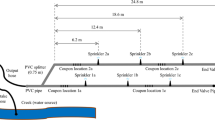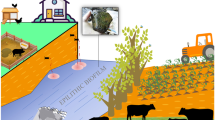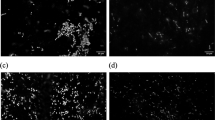Abstract
Irrigation waters have come under increasing scrutiny as a potential source of pathogenic microorganisms contaminating fresh produce. It is generally assumed that the microbial concentrations entering and leaving irrigation pipe networks are identical. However, this may not be true if biofilms form on the inner surfaces of irrigation pipes. The retention and release of pathogens in biofilms are well documented in drinking water distribution systems, but very little data are available for irrigation systems. We examined the attachment and/or incorporation of total coliform, fecal coliform, and Escherichia coli bacteria into biofilms in new and used aluminum irrigation pipe. Water from a local creek in Maryland was used to conduct weekly irrigation events. Prior to each event, removable sections of pipe (coupons) were scraped to determine the extent of bacterial attachment; in addition, bacterial concentrations in residual water were determined. Substantial populations of coliform bacteria were found on the pipe surfaces. Old pipes had fewer attached or biofilm-incorporated coliforms and lower coliform concentrations in the residual water. High probabilities were found for average fecal coliform and total coliform concentrations being different between creek water and sprinkler water. These results have implications for monitoring and control of microbial quality of irrigation waters.








Similar content being viewed by others
References
Bagh LK, Albrechtsen HJ, Arvin E, Ovesen K (2004) Distribution of bacteria in a domestic hot water system in a Danish apartment building. Water Res 38:225–235
Berry D, Xi C, Raskin L (2006) Microbial ecology of drinking water distribution systems. Curr Opin Biotechnol 17:297–302
Brandl MT (2006) Fitness of human enteric pathogens on plants and implications for food. Annual Revue Phytopathol 44:367–392
Brown D, Rothery P (1993) Models in biology: mathematics, statistics and computing. Wiley and Sons, New York
Camper AK, Jones WL, Hayes JT (1996) Effect of growth conditions and substratum composition on the persistence of coliforms in mixed-population biofilms. Appl Environ Microbiol 62:4014–4018
Chang YC, Le Puila M, Biggerstaff J, Randall AA, Schulte A, Taylor JS (2003) Direct estimation of biofilm density on different pipe material coupons using a specific DNA-probe. Mol Cell Probes 17:237–243
DehghaniSanij H, Yamamoto T, Rasiah V, Utsunomiya J, Inoue M (2004) Impact of biological clogging agents on filter and emitter discharge characteristics of microirrigation systems. Irrigation Drain 53:363–373
Fass S, Dincher ML, Reasoner DJ, Gatel D, Block J-C (1996) Fate of Escherichia coli experimentally injected in a drinking water distribution pilot system. Water Res 30:2215–2221
Foppen JW, Lutterodt G, Röling WFM, Uhlenbrook S (2009) Towards understanding inter-strain attachment variations of Escherichia coli during transport in saturated quartz sand. Water Res 44:1202–1212
Gerba CP (2009) The role of water and water testing in produce safety. In: Fan X, Niemira BA, Doona CJ, Feeherty FE, Gravani RB (eds) Microbial safety of fresh produce. Wiley and Sons, New York, pp 129–142
Guida L, Ssidi Z, Hughes MN, Poole RK (1991) Aluminum toxicity and binding to Escherichia coli. Arch Microbiol 156:507–512
Hallam NB, West JR, Forster CF, Simms J (2001) The potential for biofilm growth in water distribution systems. Water Res 35:4063–4071
I.S.H.A (2010) Validation study of the Colilert®-18/Quanti-Tray® method for the enumeration of Escherichia coli and coliforms in water for human consumption. Summary Report. Institute Scientifiqued’Hygiene & d’Analyse, Massy, France. Available as http://www.idexx.com/pubwebresources/pdf/en_us/water/colilert-18-afnor-report.pdf
Kilb B, Lange B, Schaule G, Flemming HC, Wingender J (2003) Contamination of drinking water by coliforms from biofilms grown on rubber-coated valves. Int J Hyg Environ Health 206:563–573
Klapper I, Dockery J (2010) Mathematical description of microbial biofilms. SIAM Rev 52:221–265
LeChevallier MW, Lowry CD, Lee RG, Gibbon DL (1993) Examining the relationship between iron corrosion and the disinfection of biofilm bacteria. J Am Water Works Assoc 85:111–123
LeChevallier MW, Welch NJ, Smith DR (1996) Full-scale studies of factors related to coliform regrowth in drinking water. Appl Environ Microbiol 62:2201–2211
Lehtola MJ, Nissinen TK, Miettinen IT, Martikainen PJ, Vartiainen T (2004a) Removal of soft deposits from the distribution system improves the drinking water quality. Water Res 38:601–610
Lehtola MJ, Miettinen IT, Keinanen MM, Kekki TK, Laine O, Hirvonen A, Vartiainen T, Martikainen PJ (2004b) Microbiology, chemistry and biofilm development in a pilot drinking water distribution system with copper and plastic pipes. Water Res 38:3769–3779
Li Y, Zhou B, Liu Y, Jiang Y, Pei Y, Shi Z (2012) Preliminary surface topographical characteristics of biofilms attached on drip irrigation emitters using reclaimed water. Irrigation science. Published online. doi:10.1007/s00271-012-0329-1
Mara DD, Sleigh PA, Blumenthal UJ, Carr RM (2007) Health risks in wastewater irrigation: comparing estimates from quantitative microbial risk analyses and epidemiological studies. J Water Health 5:39–50
Morton SC, Zhang Y, Edwards MA (2005) Implications of nutrient release from iron metal for microbial regrowth in water distribution systems. Water Res 39:2883–2892
Neogen (2011) MacConkey agar. Available at http://www.neogen.com/Acumedia/pdf/ProdInfo/7102_PI.pdf
Pachepsky Y, Sadeghi AM, Bradford SA, Shelton DR, Guber AK, Dao T (2006) Transport and fate of manure-borne pathogens: modeling perspective. Agric Water Manag 86:81–92
Pachepsky Y, Shelton D, McLain J, Patel J, Mandrell R (2011) Irrigation waters as a source of pathogenic microorganisms in produce: a review. Adv Agron 113:71–136
Pachepsky Y, Morrow J, Guber A, Shelton D, Rowland R, Davies G (2012) Effect of biofilm in irrigation pipes on microbial quality of irrigation water. Lett Appl Microbiol. doi:10.1111/j.1472-765X.2011.03192.x
Pagan R, Mackey B (2000) Relationship between membrane damage and cell death in pressure-treated Escherichia coli cells: differences between exponential- and stationary-phase cells and variation among strains. Appl Environ Microbiol 66: 2829–2834
Pina RG, Cervantes C (1996) Microbial interactions with aluminum. Biometals 9:311–316
Riehle MM, Bennett AF, Lenski RE, Long AD (2003) Evolutionary changes in heat-inducible gene expression in lines of Escherichia coli adapted to high temperature. Physiol Genomics 14:47–58
Sadovski AY, Fattal B, Goldberg D, Katzenelson E, Shuval HI (1978) High levels of microbial contamination of vegetables irrigated with wastewater by the drip method. Appl Environ Microbiol 36:824–830
Santillana Farakos SM, Zwietering MH (2011) Data analysis of the inactivation of foodborne microorganisms under high hydrostatic pressure to establish global kinetic parameters and influencing factors. J Food Prot 74:2097–2106
Silhan J, Corfitzen CB, Albrechtsen HJ (2006) Effect of temperature and pipe material on biofilm formation and survival of Escherichia coli in used drinking water pipes: a laboratory-based study. Water Sci Technol 54:49–56
Stine SW, Song I, Choi CY, Gerba CP (2005) Application of microbial risk assessment to the development of standards for enteric pathogens in water used to irrigate fresh produce. J Food Prot 68:913–918
US EPA (2002a) Health risks from microbial growth and biofilms in drinking water distribution systems. http://www.epa.gov/ogwdw/disinfection/tcr/pdfs/whitepaper_tcr_biofilms.pdf. Accessed on 2/4/2012
US EPA (2002b) Methods for measuring the acute toxicity of effluents and receiving waters to freshwater and marine organisms, 5th ed. EPA 821-R-02-012, Section 7.2.3.1, p 32. US EPA, Office of Water, Washington, DC
US EPA (2005) Manual for the certification of laboratories analyzing drinking water.criteria and procedures. Quality Assurance. Fifth Edition. EPA 815-R-05-004. US Environmental Protection Agency. Office of Water. Office of Ground Water and Drinking Water. Technical Support Center. Cincinnati, Ohio 45268
US CDC (2012) Foodborne Outbreak Online Database (FOOD). http://wwwn.cdc.gov/foodborneoutbreaks/Default.aspx. Accessed on 2/14/2012
USGS (2012) USGS Water-Quality Data for Maryland. Available at the web at http://waterdata.usgs.gov/md/nwis/qw. Accessed on 03/22/2012
Vanlint D, Mitchell R, Bailey E, Meersman F, McMillan PF, Michiels CW, Aertsen A (2011) Rapid acquisition of gigapascal-high-pressure resistance by Escherichia coli. mBio 2(1):e00130-10. doi:10.1128/mBio.00130-10
Williams MW, Braun-Howland EB (2003) Growth of Escherichia coli in model distribution system biofilms exposed to hypochlorous acid or monochloramine. Appl Environ Microbiol 69:5463–5471
Yu J, Kim D, Lee T (2010) Microbial diversity in biofilms on water distribution pipes of different materials. Water Sci Technol 61:163–171
Author information
Authors and Affiliations
Corresponding author
Additional information
Communicated by K. Stone.
Rights and permissions
About this article
Cite this article
Shelton, D.R., Kiefer, L.A., Pachepsky, Y.A. et al. Coliform retention and release in biofilms formed on new and weathered irrigation pipes. Irrig Sci 31, 971–981 (2013). https://doi.org/10.1007/s00271-012-0373-x
Received:
Accepted:
Published:
Issue Date:
DOI: https://doi.org/10.1007/s00271-012-0373-x




